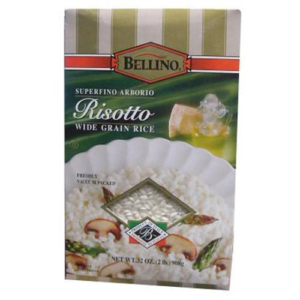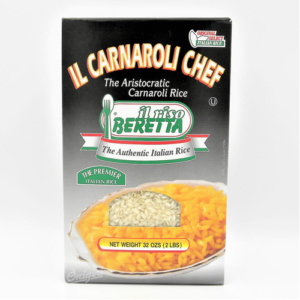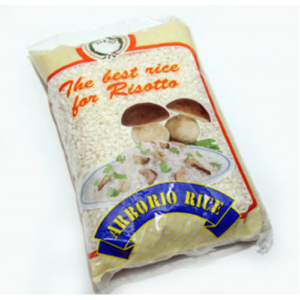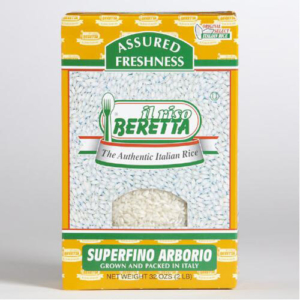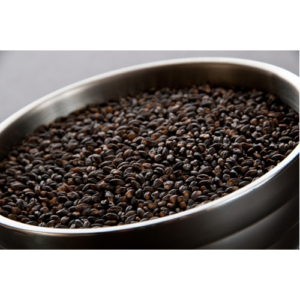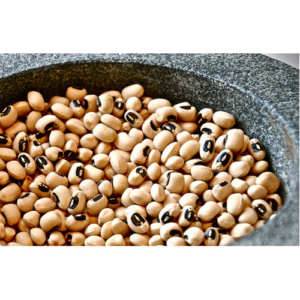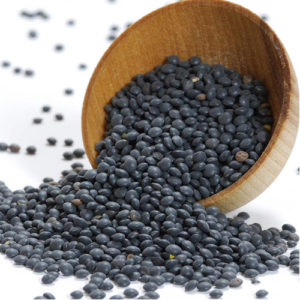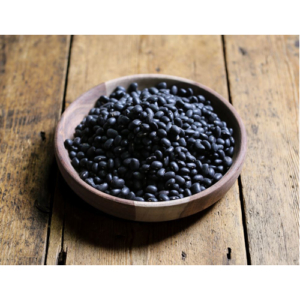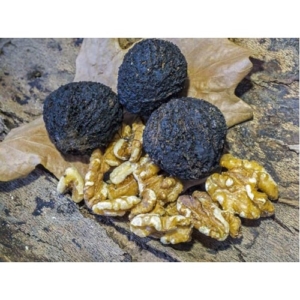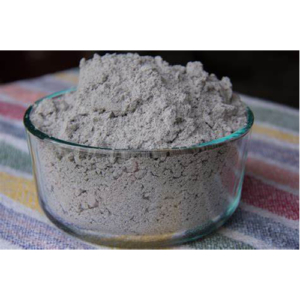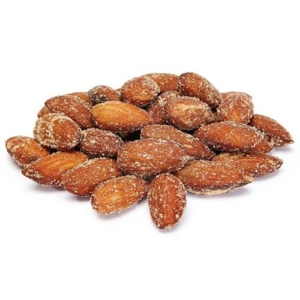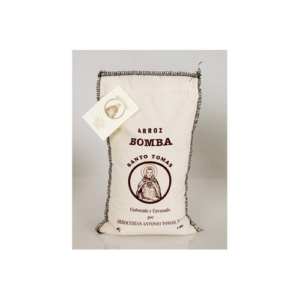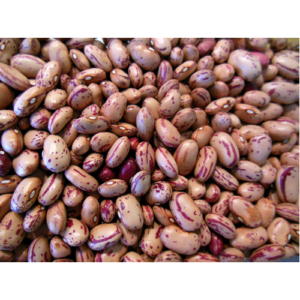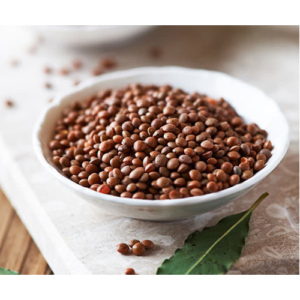- Display 15 Products per page
-
BELLINO SUPERFINO ARBORIO RICE
Wide grain Italian rice enriched with iron and essential vitamins. Vacuum packed for freshness. No cholesterol. Low fat.
-
BERETTA, CARNAROLE RISOTTO
Carnaroli rice is grown in the Piedmont and Lombardy regions of northwest Italy. A short grain, plump Italian white rice, Carnaroli is considered one of the best rices to use in risotto. Carnaroli has a larger grain than the other Italian white rice varieties, but still cooks to a creamy texture with a firm body. Widely considered the finest of the risottos rice varieties, carnaroli has been nicknamed the caviar of rice. It is slightly more sensitive with regard to cooking time and can absorb large amounts of liquid, but carnaroli’s creamy texture and improved flavor keep it a favorite for chefs everywhere risotto is popular.
-
BERETTA, SUPERFINO ARBORIO RICE
Arborio, the best known superfino variety of Italian rice, traditionally forms the basis of risotto. Its high starch content is released in the slow cooking process, creating a creamy, butter-like consistency. Arborio grains are round and fat with a pearly-looking sheen. Like other rices, Arborio is a member of the grass family.
-
BERRETA SUPERFINO ARBORIO RICE
Superfino Arborio rice is the most popular rice used in the preparation of Risotto dishes because it’s increased starch lends this classic rice dish its requisite creamy texture. Arborio rice, the high-starch kernels of this Italian-grown grain, are shorter and fatter than any other short-grain rice. – Product of Italy.
-
BLACK BARLEY
Black Barley is also known as Purple Hull-less Barley. Originally from Ethiopia, this variety has not been raised until recently because of the low yield. This is actually the only grain that can go from field to table without being processed, because the gloom or bran layer stays attached to the kernel, and is edible.
Suggested Use:The shape of this hearty grain resembles a coffee bean and cooks to a glossy purplish-mahagony color. It is wonderful in soups and stuffings or alone as a beautiful alternative to rice (Because of a somewhat chewy texture, it is best mixed with other grains.)
Basic Prep:Rinse well, add 1 cup of barley to 3 cups of boiling water. Simmer covered 35-40 minutes until liquid is absorbed. For a fluffier grain, soak Barley in water for 5 hours then simmer covered for 15 minutes. One cup dry yields 3-1/2 to 4 cups cooked.
-
BLACK EYE PEAS
Black Eyed Peas (Vigna Unguiculata) are related to the Mung Bean. These beans are medium sized cream colored beans with a ‘Black Eye’ on the inner curve of the bean. Black Eyed Peas are about 3/8 long and have a sweet, mild pea-like flavor and firm texture. The Black Eyed Pea absorbs the flavors of a dish very well. Also referred to as a Black Eyed bean, Cow Pea, Field Pea, Tonkin Pea, China Pea, Marble Pea, Brown Eyed Pea, Jerusalem Pea, Black Eyed Suzy and Lobhia.This bean is believed to have originated in Eastern Asia. It was brought to the Americas with the African slave trade. Black Eyed Beans were a staple of many plantation diets. Eaten on New Year’s Day, Black Eyed Beans are thought to bring good luck for the following year.
Suggested Use:This fast cooking legume lends itself to many recipes. It mixes well with a variety of greens, including Okra, Collard and Swiss Chard. Hoppin’ John is a traditional souther recipe using this bean.
Basic Prep:Soak overnight. Rinse and place in a large pot and cover with fresh water. Bring water to a boil for 3 minutes, reduce heat and simmer, covered, for 30-45 minutes until tender. Do not over stir or the soft skins can be damaged. One cup dry yields 2 cups cooked.
-
BLACK LENTILS
Black Lentils are a very popular legume in South Asia, they are used to make a beautiful black lentil soup. Black Beluga Lentils are 1/2 cm. wide with a mild, earthly flavor and soft texture. This tiny lens shaped pulse has traditionally been used as a meat substitute (A pulse is the dried seed of any legume, such as beans and peas). Lentils are the seed of a small shrub and are dried after harvesting.
Suggested Use:The quick cooking and nutritious nature of lentils make them an obvious choice for winter soups. They’re delicious in chilled vegetable salads, or mix with bread crumbs, minced onion and garlic to stuff roasted red peppers or eggplant.
Basic Prep:Lentils do not require soaking. Simmer 1 cup lentils with 4 cups water 12 minutes for salads, 20 to 30 minutes for main dishes, drain. Skim the water while cooking. One cup dry yields 2 cups cooked.
-
BLACK TURTLE BEANS
Black Turtle Beans (Phaseolus vulgaris) are related to the Kidney Bean. Black Turtle Beans are also known as Black Beans. Turtle Beans are small, kidney shaped with a slight rectangular look. These beans are black, shiny and have a slight mushroom flavor. Black Beans hold their shape when cooked and absorb flavors well. Native to South America, Black Turtle Beans are an important ingredient in Brazilian and Cuban dishes.
Suggested Use:Black Turtle Beans have a deep flavor which works well in soups, such as Cuban Black Bean soup. They are also good in frijoles refritos, and chili. Cooked in a savory broth, Black Beans can stand alone with a dish of rice.
Basic Prep:Soak overnight. Rinse and place in a large pot and cover with fresh water. Bring water to a boil for 3 minutes, reduce heat and simmer, covered, for 60 minutes until tender. One cup dry yields 2-1/4 cups cooked. salt the water to your desired liking.
-
BLACK WALNUTS
The nutmeats provide a robust, distinctive, natural flavor and crunch as a food ingredient. Popular uses include ice cream, bakery goods and confections. Consumers include black walnuts in traditional treats, such as cakes, cookies, fudge, and pies, during the fall holiday season. The nuts’ nutritional profile leads to uses in other foods, such as salads, fish, pork, chicken, vegetables and pasta dishes.
-
BLUE CORN MEAL
Blue Cornmeal is milled from an open-pollinated blue flour corn selected from traditional Southwest native varieties. Because of its unique starch characteristics, baked products made with our blue cornmeal come out especially light and tender.
-
BLUE DIAMOND, ALMONDS, WHOLE, SMOKED
Say the phrase Blue Diamond and many people think Smokehouse. First introduced in 1958, our signature Smokehouse® Almonds are among our top sellers. One taste will tell you why they’ll never go out of style. Buy them by the can, eat them by the handful. They are a flavor-filled treat packed with goodness.
-
BOMBA RICE
It is a short grain variety with a pearled color. Its size is equivalent to that of the short grain rice, sometimes even smaller, yet Bomba rice more than doubles its size when cooked. Its main characteristic is its great capacity to absorb flavors and aromas and that when cooked it is always “al dente,” loose and whole.
-
BORLOTTI BEANS, IMPORTED
Cranberry (Borlotti) Beans (Phaseolus Vulgaris) are related to the Kidney Bean (Phaseolus Vulgaris). Cranberries are like the Pinto Bean but reversed in color with pink skin and maroon mottling. They are somewhat plumper than the Pinto and are about 1/2 inch long. Cranberry Beans have a sweet, mild flavor. Also referred to as a borlotto, crab eye, roman, romano, rosecoco or saluggia bean.They may be interchanged in recipes wherever Borlotti or Saluggia Beans are required. Like their Mexican and Italian cousins (Pinto and Kidney), they will turn pink when cooked.
Suggested Use:In Italy, Cranberry (Borlotti) Beans are used in pasta dishes and soups. Add them to rice dishes, stews, casseroles, cold bean and vegetable salads. For a quick and flavorful salad toss the beans with crumbled gorgonzola cheese, olive oil and a dash of fresh rosemary.
Basic Prep:Soak overnight in plenty of water. Drain, rinse and place in a large pot that has a lid. Add enough water to cover beans by 1 inch. Bring to a boil for 3 minutes, reduce heat and simmer, covered, for 45 minutes until tender. One cup dry yields 3 cups cooked.
-
BRAZIL NUTS
Brazil nuts are one of the finest sources of energy, healthy fats, vitamin E, and selenium. Selenium is an important cofactor for anti-oxidant enzyme. Brazil nuts can be eaten all alone, or used in fudge, puddings, pesto, chocolates-bars.
-
BROWN LENTILS
Spanish Pardina Lentils(Lens esculenta) have been eaten for over 8000 years. Lentils originated in Southwestern Asia along the Indus River. They are a staple food for many South Asian cultures. The Latin word for lentil, lens, was used in the 17th century to describe eye glasses. This is because of the similarity in shape between the legume and an eyeglass lens. Lentils are the seed of a small shrub. Lentils do not require soaking. Simmer 1 cup lentils with 4 cups water 12 minutes for salads, 20 to 25 minutes for main dishes. Skim the water while cooking, drain. One cup dry yields 2-1/4 cups cooked.

